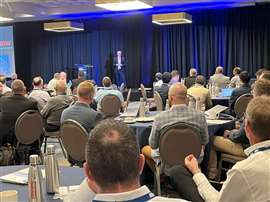Read this article in Français Deutsch Italiano Português Español
Cummins exec on the role of AI in the energy transition
28 October 2024
As implied by the theme of this year’s Power Progress Summit (“Developments in Digitalization and Decarbonization”), technologies to facilitate the energy transition extend beyond carbon-reducing solutions. Higher level tools such as artificial intelligence (AI) will be a necessary part of moving the transition forward, as day one keynote speaker Brad Sutton, executive director – Powertrain Engineering, Cummins, pointed out.
 “We have to transition our thinking from just internal efficiencies with the technology we have to [how] can we add value to our customers and our end users.” - Brad Sutton, executive director – Powertrain Engineering, Cummins (Photo: Eason Photography)
“We have to transition our thinking from just internal efficiencies with the technology we have to [how] can we add value to our customers and our end users.” - Brad Sutton, executive director – Powertrain Engineering, Cummins (Photo: Eason Photography)
Sutton kicked off his presentation by discussing his background in engineering and the progress he’s seen since he started out writing troubleshooting trees for Cummins’ first electronic fuel system 35 years ago through to the data-based prognostic solutions available today. Yet, he sees the possibility to do even more with that data.
“The internal efficiencies we’ve already gained,” he said, noting most engineering service companies and other manufacturers cite anywhere from 20% to 50% efficiency gains just by having the data to make decisions faster with less on-site investigation, less material inspection, etc. “But the reality is, I really think we’re just starting to scratch the surface in what this real data can do for us.
“We have to transition our thinking from just internal efficiencies with the technology we have,” he said, “to [how] can we add value to our customers and our end users.”
Fast forward with AI
Tool sets such as AI could help the industry to make the energy transition far more rapidly.
“As we think about moving forward with AI, it’s hard to fathom how fast this is going to move,” Sutton commented. “The ability to make decisions, to go through data, to understand anomalies, to understand different causations – it is extremely fast and almost overwhelming.”
As an example, he cited a study he reviewed that included 200,000 vehicles with an average lifespan of about five years. “You’re going through and trying to pick out three parameters that are going to drive better fuel economy. That’s tough, right?”
AI can rapidly sift through that data to help customers understand how to make the right decisions for their product mix based on factors such as equipment or vehicle duty cycles; how they operate; the availability of fuels such as renewable natural gas, etc., said Sutton.
 Cummins’ Brad Sutton addresses attendees at the Power Progress Summit. (Photo: Eason Photography)
Cummins’ Brad Sutton addresses attendees at the Power Progress Summit. (Photo: Eason Photography)
“I also like to think about proactive kind of fleet recommendations,” he continued. “How many times, if you’re ever around the commercial vehicle space, does a large fleet come in and say, ‘I’ve got an ESG problem or I have an ESG target, can you help me meet it?’ That’s sort of an overwhelming ask. But with these tools, we can optimize their fleet in terms of power, whether it’s diesel, gasoline, hydrogen, natural gas, renewable natural gas, and even whether it’s new power.”
Given the higher cost of new power system technology, total cost of ownership is also a major concern that Sutton believes AI can help to address. “As we run a more optimized fleet or more optimized approach, we can show that TCO to every customer out there, and that’s huge for them. And we can do that fast.”
Collaboration for safety’s sake
Safety is another aspect of vehicle operation that AI can help enable, said Sutton.
“If we think about some of the safety systems on vehicles, how do you take the operational modes of the safest drivers and operators in the industry, and then link that with technology?” he asked. “AI can be an enabler for us to understand… those safe populations [and] those unsafe populations. What are the things that are common? What are the things that are different? How do we drive that to every vehicle and every operator to train those vehicles and those operators to be that safest example?”
He noted that safety will be a “huge deal” for Cummins in moving forward with AI. However, one company can’t affect change alone.
“The reality is, we can’t do this individually. We need collaboration across the entire industry. We need fleets helping us understand what those safe operations are,” Sutton emphasized. “We need OEMs and others to help us to collaborate and innovate together.
“Using AI to help us get there faster is right here, right now,” he continued. “But we have to break down those walls in the industry and start to collaborate, share information, share best practices, share what doesn’t work, share what does work and try to help each other get there.”
POWER SOURCING GUIDE
The trusted reference and buyer’s guide for 83 years
The original “desktop search engine,” guiding nearly 10,000 users in more than 90 countries it is the primary reference for specifications and details on all the components that go into engine systems.
Visit Now
STAY CONNECTED




Receive the information you need when you need it through our world-leading magazines, newsletters and daily briefings.
CONNECT WITH THE TEAM













